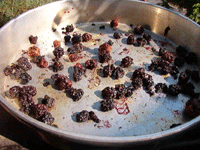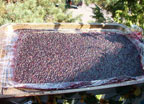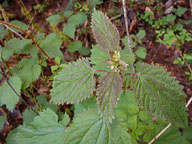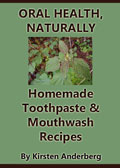Welcome to Kirsten's Herbal Garden...BLACKBERRIES
 Drying berries outside in the sun is very simple, these berries are drying in Seattle Wa. (Photo: K. Anderberg 2006)
Drying berries outside in the sun is very simple, these berries are drying in Seattle Wa. (Photo: K. Anderberg 2006)If you look at the ingredients list for most of the Celestial Seasonings Teas, you will see blackberry leaf is a predominant ingredient in most of their tea blends. You can dry your
own blackberry leaves for tea! Boil some water, take it off of the stove, add some blackberry leaves, let it steep a while, then add some honey and drink. You can add ice if it is summer.
Blackberry leaves have a refreshing, green taste to them. It is best to gather blackberry leaves in the spring, when the new buds are out and fresh, tender, light green baby
leaves are available. Those are the sweetest. Larger and older the leaves are less sweet.
Fresh or powdered, dried blackberries were added to water, then sweetened with honey or maple syrup, then used as a beverage, by American Indians.
You can make wonderful
berry cordials by crushing enough blackberries in a strainer to make one quart of blackberry juice. Put juice in pan and add 1 pound of sugar. Then tie up in cheesecloth or a
muslin tea bag: 2 t. each of powdered cinnamon, allspice, and nutmeg and 1 t. of powdered cloves. Add to the juice and sugar. Heat to a boil, then simmer for 15 minutes.
Skim, then cover and let cool. Once cold, strain, and add 1 pint of brandy. Then bottle it up and seal it. You will be happy you did in the winter months!
Blackberries grow like weeds all over the Pacific Northwest. You can spend a few hours berry picking, and then
processing berries, to use them all year long. Berries rot on vines all over, but if you spend the time to pick them, and freeze, dry, or can them, you can use that abundant
wild food source for months to come. My kid laughed at me when I packed the freezer with blackberries last summer. But he was really thankful later, and said so,
when we had berry smoothies, berry pies, etc. all winter long. You can pick blackberries daily, and do all kinds of things with them. Make jam, wine, tea, ink, dyes,
fruit leather, medicine...You can also collect the early leaf shoots that come out in the spring and dry them for use all year long in teas, baths, etc.
Fossil evidence shows humans have been eating blackberries since ancient times. For over 2000 years, Europeans have been using blackberries as food and medicine. In ancient
times, people chewed blackberry leaves, or made tea out of boiled blackberry shoots, to relieve mouth ailments, cancer sores, and bleeding gums. It is suspected that the
property that relieves the mouth ailments is probably the astringent quality of blackberry plants. Blackberry plants have been used medicinally, by American Indians to
Greek doctors, most commonly to stop diarrhea and for mouth ailments. It is said blackberries used to be dried once picked, then pulverized into a powder, then stored as a
medicine. The dried powder would be mixed with a little water and used to treat diarrhea when needed. Blackberries contain a high amount of Vitamin C, so they were
"prescribed" for scurvy in the past. And cosmetically, blackberry leaves can be added to bath water to enliven skin. Put a handful of dried leaves in a cotton/muslin tea bag,
and drop into a bath. And teas from blackberry leaves can be found on grocery store shelves all over America in teas, including Celestial Seasonings' "Sleepytime Tea" and most of the
rest of their teas as well.
American Indians made a strong rope out of blackberry stems. And you can dye things with blackberry plant parts, including hair, according to legend. Supposedly blackberry
parts and lye were mixed for a permanent black hair dye at some point in history, while other accounts simply mention using the leaves to dye hair. Accounts say the berries,
leaves, and roots dye fabrics everything from yellow to gray to purple to green. You can make a writing ink out of the berries, by crushing 1/2 cup of ripe blackberries through
a strainer, pushing the berries down with the back of a spoon to juice them, and collecting the juice in a bowl underneath. Add 1/2 t. vinegar and 1/2 t. salt to the juice. The
salt acts like a preservative, and the vinegar helps keep the color. If it is too thick, you can add a little water. Store it in a small glass jar with a tight lid. (Blackberry
ink is a drag if it spills!) Make small amounts at a time and keep tightly covered in the refrigerator when not using. It is said you can just pound berries, and add water, for
ink also.

Symbolically, blackberry brambles have meant different things to different cultures. In some cultures, brambles are a symbol of lowliness and remorse, as they trip and catch you with thorns, like regret. A blackberry bramble can choke out other plants, and thus it is also symbolic of a person who is greedy or overbearing. Blackberry brambles have also been used historically as barriers, to keep animals, and human enemies, out of areas people wanted secured, thus they also symbolize walls and separation.

Drying berry fruit leather outside in summer sun. (Photo: K. Anderberg 2006)
You can freeze blackberries, and they freeze well. Just lay them out, individually, on a cookie sheet right after picking (do not wash), and put them in the freezer. Once frozen, throw them into freezer bags like frozen peas. You can dry the leaves by taking a piece of string or thread, and tacking it to one end of a corner in a room, and tacking the other end to the other wall of the corner. Now string blackberry leaves, hanging them by crooks in the leaves, until they are dry, then store them in jars. You can make fruit leather out of berries by making a puree out of the berries (you can also add a bit of lemon juice) in a food processor or blender, then straining most of the seeds out. Pour the puree onto cookie sheets, platters, etc. in a thin layer. Then place in the hot sun, and let dry. It may take a few days, so take the leather in at night. When dried, roll them up and store in jars.
Finally, you can make sun jam out of blackberries. Mix 4 cups of fresh blackberries with 3 cups sugar and 2 T. lemon juice and let sit, covered for an hour. Then bring the mixture to a boil over medium heat, stirring constantly. Then turn heat up to hot, and let boil fully for 4 minutes, uncovered, without stirring. Take the pan off the stove and let cool, uncovered, for half an hour. Next pour the mixture into a shallow pan, such as a roasting pan, or shallow trays. Pour no deeper than 3/4 inch, but no less than 1/3 inch deep. Cover with plastic wrap, leaving one small edge open to breathe. Put in direct sunlight, and stir the mixture every hour. Stirring is really essential. Once the liquid in the pan is the consistency of corn syrup, and the fruit is plump, remove from sun. It will still thicken as it cools also. In tests making this jam, it took 10 hours to make in Seattle, and 2 hours to make in Phoenix. You may even need to take it in at night, and let it stew for two days. Once finished, you can put the jam into jars and refrigerate, it will be good for about 4 weeks. Or you can put the jars into freezer containers, leaving 1 inch at top, and then sealing and freezing. Or you can put the jam into canning jars, and process them according to usual canning procedures.
The idea is to get out there and collect berries now while you can, for as long as the season will render its fruit. If you do not end up using the berries to make cordials you give out as presents during the winter, or to make ink with kids on a boring summer day, you can enjoy them in smoothies, and pies, teas and jams. And everyone loves to receive wild-crafted, homemade blackberry jam!
Susunweed.com, has a Wise Woman Forum with information on wildcrafted foods, herbs, etc.
BLACKBERRY JAM -
3 lbs. Blackberries ** 1 lb cooking apples, diced ** 4 lbs. Sugar ** 1/2 pt water
Cook berries and apples slowly until soft. Add sugar, boil until set, then can properly or use within few weeks refrigerated.
BLACKBERRY SYRUP -
Stew blackberries, 3 lb fruit to 1/4 pt. water, until juice is drawn...strain, add for every pint of juice, 6 oz sugar. Boil 15 min, then bottle after cooling.
Abbreviations: (t. = teaspoon, T. = Tablespoon, c. = cup)
DISCLAIMER: Do not eat or drink tea from any plant you have not fully studied and identified properly. Please consult with your local alternative herbal care specialist before using herbs you are not familiar with.
 |
Anise * Blackberries * Calendula * Cloves * Comfrey * Eucalyptus * Fennel * Horsetails * Lavender * Mint * Nettles * Red Clover * Roses * Rosemary * Sage * Selfheal * Thyme * BABIES & MOMS * BATHS * BUG REPELLENTS * FEET * HAIR * LIPS * MAKEUP * MISC * SKIN * TEETH * WOMEN * |
Thank you to Resist.ca for hosting this website!
















